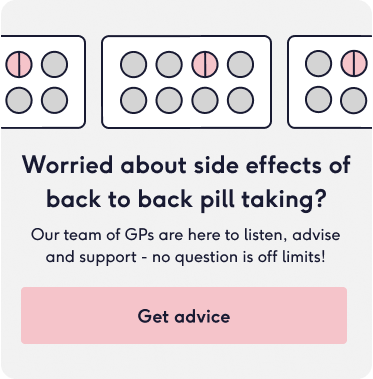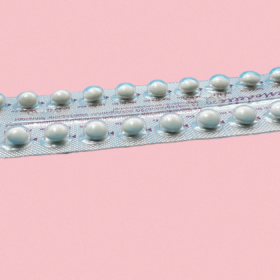
The benefits of continuous pill taking – yes you can skip a period!
In this article
What's the lowdown?
Continuous pill taking (i.e. taking your pill back to back), is completely safe and may improve its effectiveness
There are no benefits to the 7 day hormone-free break, either for your health or the effectiveness of your contraception
You can safely miss your 7 day break or skip inactive pills on occasion or continually – in fact taking the pill back to back may reduce side effects associated with the hormone free week
There are two kinds of oral contraceptive pill: the combined pill and the progestogen-only pill (or mini pill). The combined pill has traditionally followed a 21/7 format which means taking 21 days of active hormones followed by a seven day break from pills, or 7 inactive pills, repeat.
Guidance issued in 2020, however, states that taking a combined oral contraceptive birth control pill back to back is perfectly safe and, science suggests, actually more effective than taking it for 21 days at a time with seven-day breaks in between.
Making sure you’re taking your pill correctly can be confusing at times, but it doesn’t have to be! If you‘d like to chat to one of The Lowdown’s doctors about your experience on the combined birth control pill so far and what the best contraception might be for you to help manage your periods, you can book an appointment here. Or, you can use our contraception recommender tool to advise you further on which contraceptive is best for you:
What types of hormonal contraception can you take continuously?
Most progestogen-only (mini) pills are taken continually anyway, so just keep doing your thing. You can buy the progestogen-only pill (including the mini pills Hana, Noriday and Desogestrel) here at The Lowdown.
If you’re taking a combined oral contraceptive pill like Yasmin, Microgynon contraceptive pill or Rigevidon however, or if you’re using another form of combined contraception, like the vaginal ring or the patch, listen up.
How do I use the birth control pill to skip bleeds?
If you use pills that come in a 21 day packet, it’s easy, just don’t have a break between packs and move straight into another packet. If you use 28 day pill packets which include both active and inactive or reminder pills (which are usually a different colour), just skip the last 4 to 7 different coloured pills in the packet and move straight onto another packet, starting with the active pills.
By ignoring the inactive pills or skipping the break you won’t be induced to have a withdrawal bleed….yippee!
Is taking the pill back to back safe?
Research shows that taking the combined contraceptive pill back to back is absolutely safe. In fact, there’s no evidence at all that shows any health benefits associated with the seven-day break and withdrawal bleed.
The Family Planning Association now explicitly states that withdrawal bleeds hold no known benefits, and that there are no risks associated with missing them altogether.
Some women are understandably concerned about taking their pill continuously and missing their ‘period’. The reality, though, is that the bleed you experience during your seven-day break isn’t a period at all.
Allow us to go back to basics for a second. When you aren’t taking hormonal contraception or birth control, the lining of your uterus thickens throughout the middle and end of your cycle, readying itself for a fertilised egg to be implanted. When fertilisation doesn’t happen, the lining sheds, and this is your period.
Combined hormonal contraception, on the other hand, prevents your ovaries from releasing an egg, and stops the lining of the uterus from thickening as it would during your ordinary cycle. The aptly-named ‘withdrawal bleed’ you experience during your seven-day break is just that: your body’s response to the withdrawal of the hormones contained in your pill.
In short, withdrawal bleeds are completely unnecessary in terms of their effect on your health or the effectiveness of your contraception. We know – mind-blowing.
This is also true for the contraceptive patch and the vaginal ring, both of which administer oestrogen and progestogen, traditionally in a 21/7 format.

Check out more Trustpilot reviews of The Lowdown here!
What are the benefits of taking the combined pill continuously?
It can make your pill more effective
Even more interestingly, taking your pill continuously might actually improve how effective it is. When you take the pill, you’re essentially putting your ovaries to sleep, interrupting your cycle and preventing pregnancy. After the seven-day break or inactive reminder pills, your ovaries ‘wake up’ again, so if you were to forget to take your pill for a couple of days afterwards, your risk of pregnancy would increase.
It can reduce the side effects of the pill
The side effects of taking your pill continuously shouldn’t be any different from those of taking the pill in general, but this type of ‘tailored’ contraception taking might alleviate some of the less desirable symptoms of your withdrawal week.
Like we said earlier, the bleed you experience during the break in your pill doesn’t actually need to happen; it provides no benefits to your health or the effectiveness of your contraception. While this bleed isn’t a period, it may come with some similar symptoms (pain, PMS, headaches) which are lessened or eliminated when you don’t have a break. You might still experience some bleeding or spotting with continuous pill taking, but this should lessen over time¹.
If you’re having trouble with side effects from the pill, have tried a few but can’t find one that suits you, or just want a bit more guidance on your contraception options, our team of Lowdown GPs can help!
It’s easier to remember
It’s also easier to remember to take a pill every day (no more snoozing those phone alarms for a week every month), meaning there’s less risk of you forgetting and reducing its effectiveness against pregnancy.
This kind of pill-taking, where the pill is administered differently to the advice on the box, is called ‘tailored combined hormonal contraception’. It’s outside the manufacturer’s license, meaning they can’t direct you to take it in this way, but it is supported by the Faculty of Sexual and Reproductive Healthcare, who write the rules about how contraception is used in the UK. Continuous combined birth control pills were also approved by the FDA in the US in 2007.

You can skip a period (and say goodbye to bleeds)
We’re sure you don’t need us to list the benefits of not bleeding every month (no sanitary products, white jeans, yes please) but for most of us, the withdrawal bleed is mistakenly seen as a reassuring sign that our contraception is actually working.
Combined hormonal contraception, however – when taken correctly – is incredibly effective. Add to this the fact that your chances of missing a pill are reduced when it’s taken back to back, and the increased efficacy when your seven-day break is missed, and your chances of pregnancy are very slim.
Withdrawal bleeds are also not a normal period and have been reported by people using combined methods of contraception who are pregnant. You should not consider having monthly bleeds on combined contraception to be reassurance that you are not pregnant.
If there’s no benefit to the 7-day break, why was the pill developed this way in the first place?
Well, some say that it was to help get approval from the Pope, as the body would still be following its ‘natural’ rhythm. Mostly, however, it’s due to the fixed mindset at the time the pill was developed: having monthly bleeds was seen as ‘normal’ and, incorrectly, necessary.
How long can you keep taking the pill back to back?
Current research doesn’t point to any time limits for continuous pill taking; in fact, a 2018 paper² actually recommended ditching the 7-day withdrawal altogether and adopting a continuous regimen. For women who prefer a monthly bleed, the researchers recommended a 4-day break or 4-days of inactive reminder pills, as this was deemed more effective in terms of pregnancy prevention than a 7-day withdrawal.
There is also no evidence to show that missing breaks occasionally is less safe than missing them altogether.
Check out the ‘Pill taking’ highlight on our Instagram stories for an overview of this and a fascinating interview with Professor John Guillebaud, who has been campaigning for more education on back-to-back pill taking for years.
What do I do if I keep getting breakthrough bleeding?
Some irregular bleeding and spotting are totally normal during the first few months of continuous pill taking. This does tend to lessen over time, though, and most women find that it becomes less of an issue when it does occur.
If you’ve had spotting or bleeding for more than a few days, and it hasn’t settled after 21 consecutive days of beginning the pill (or three weeks after an earlier break), stop taking the pill for four days before beginning again. After the four days have passed, start a new pack from the pill that matches the current day, throwing away the ones from the days you missed.
You don’t need to contact your healthcare provider before trying this way of taking the pill, and it usually works to lessen or stop any bleeding or spotting. If it doesn’t settle, however, do check out our blog on spotting on contraception and when you should see your GP.
If you do decide to take a four-day or seven-day break, there’s no need to use any other forms of contraception; as long as you’ve taken 21 consecutive active pills, your pill will continue to protect you against pregnancy.
My doctor/pharmacist hasn’t heard of continuous pill taking – what should I do?
The push for more women to have the option of taking the combined pill back to back is relatively recent, and unfortunately it can take time for changes in guidance to reach GPs and other healthcare providers.
If your doctor or pharmacist hasn’t heard of the new guidelines, download the Family Planning Association’s leaflet⁴ about combined contraception and take it with you, referencing pages 11 and 12.
Don’t be shy in telling them that the guidance has changed; your healthcare provider will want to work with you to make sure you’re making the most informed choice!
Our medical review process
This article has been medically reviewed for factual and up to date information by a Lowdown doctor.






